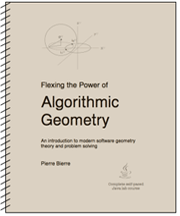
Algorithmic Geometry Software is having a profound impact on the way spatial problems are solved. |
For Educators
Sputnik ignited a grass-roots movement among teachers to modernize the high school science curriculum. That groundswell worked in spades for decades. International competitiveness is driving the current imperative to revamp math education for the 21st century. Consider this: The geometry content tested on SAT-I hasn’t changed one iota in 50 years! During this time, the software revolution has had a profound impact on the way spatial problems are solved. Think google earth, 3D animation, robotics, GPS, protein design, computer vision. Too many educators are lulled into thinking “technology” interventions like Sketchpad equate to being up-to-date with high-tech. The giveaway is that Sketchpad reinforces precomputational math constructs (concepts solidified centuries before the advent of computing). Algorithmic Geometry signals a major leap forward in formal concepts and problem-solving methodology, designed for math-accelerated 11th and 12th graders. The jumping off point is letting go of representations optimized over the centuries for brain computation, and adopting representations well-suited to writing automated algorithms. The paradigm shift is most noticeable in the way spatial direction is represented – angles and trig are put aside in favor of direction vectors. This advance gives us a standard way to represent the directional properties of planes and lines. It also paves the way for learning how to deal with 3D coordinate rotations using matrix rotators (much preferable mentally to roll-pitch-yaw angles). Rotators open the door to taking on contemporary problems. Direction vectors are conceptually simple and powerful, but require automated number crunching – the arithmetic is beyond pencil and paper - explaining why direction vectors are barely mentioned in 9-12 textbooks. The ability to solve a geometry problem on paper via sketching, and then immediately translate the solution into an automated algorithm heralds a revolution in problem-solving that will come to differentiate 21st century math from what came before. This ability confers tremendous power, as the problem-solver builds up a sophisticated library of past mental work, stored in automated, reusable form. Nobody before the software age could experience this extension of mental power. We use a Project Based Learning (PBL) approach that develops inventive thinking. Here’s a tangible way to develop math brainpower measurably to enhance competitiveness. Our goal is to build a grass-roots coalition of math educators striving to bring students an up-to-date, power-geometry curriculum, much the same way biology and physics went through major renovations after Sputnik. We did it then, and we can do it now. |
YOU CAN HELP.....here’s how....Take a few minutes to look at
Think about getting involved. If you see yourself contributing on the cutting edge of math education, contact me about AlgoGeom.org’s 2012-2014 program: pierre@AlgoGeom.org 

|
|
Copyright 2012 Spatial Thoughtware Inc. All rights reserved. Site Credits
|